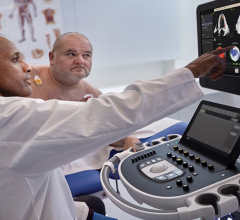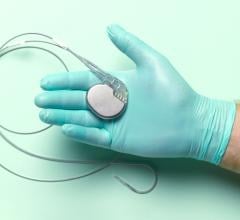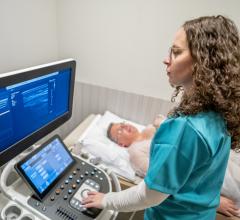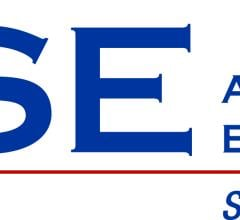
Caption Health a leader in medical AI technology, has received U.S. Food and Drug Administration (FDA) 510(k) clearance for an updated version of Caption Interpretation, which uses artificial intelligence (AI) to enable clinicians to obtain quick, easy and accurate measurements of cardiac ejection fraction (EF) at the point of care.
August 19, 2020 — Caption Health a leader in medical AI technology, has received U.S. Food and Drug Administration (FDA) 510(k) clearance for an updated version of Caption Interpretation, which uses artificial intelligence (AI) to enable clinicians to obtain quick, easy and accurate measurements of cardiac ejection fraction (EF) at the point of care.
Caption Interpretation applies end-to-end deep learning to automatically select the best clips from ultrasound exams, perform quality assurance and produce an accurate EF measurement. The technology incorporates three ultrasound views into its fully automated ejection fraction calculation: apical 4-chamber (AP4), apical 2-chamber (AP2) and the readily-obtained parasternal long-axis (PLAX) view—an industry first. While ejection fraction is commonly measured using the more challenging apical views, the PLAX view is often easier to acquire at the point of care in situations where patients may not be able to turn on their sides, such as intensive care units, anesthesia preoperative settings and emergency rooms. This software provides unprecedented access for healthcare providers to bring specialized ultrasound techniques to the bedside.
"Developing artificial intelligence that mimics an expert physician's eye with comparable accuracy to automatically calculate EF—including from the PLAX view, which has never been done before — is a major breakthrough," said Roberto M. Lang, M.D., FASE, FACC, FESC, FAHA, FRCP, professor of medicine and radiology and director of noninvasive cardiac tmaging laboratories at the University of Chicago Medicine and past president of the American Society of Echocardiography (ASE). "Whether you are assessing cardiac function rapidly, or looking to monitor changes in EF in patients with heart failure, Caption Interpretation produces a very reliable assessment."
At the point of care, a less precise visual assessment of EF is frequently performed in lieu of a quantitative measurement due to resource and time constraints. Using Caption Interpretation in these settings provides the best of both worlds: it is as easy as performing a visual assessment, but with comparable performance to an expert quantitative measurement.
Caption Interpretation was trained on millions of image frames to correctly estimate ejection fraction, emulating the way an expert cardiologist learns by evaluating EF as part of their clinical practice. While virtually all commercially available EF measurement software works by tracing endocardial borders, Caption Interpretation analyzes every pixel and frame in a given clip to produce highly accurate EF measurements.
Caption Health broke new ground in 2018 when it received the first FDA clearance for a fully automated EF assessment software. Two years later, Caption Interpretation remains the only fully automated EF tool available to providers, and, with today's clearance, continues to be the pacesetter in ultrasound interpretation.
"We are pleased to have received FDA clearance for our latest AI imaging advancement — our third so far this year," said Randolph P. Martin, M.D., FACC, FASE, FESC, chief medical officer of Caption Health, emeritus professor of cardiology at Emory University School of Medicine, and past president of the ASE. "An accurate EF measurement is an indispensable tool in a cardiac functional assessment, and this update to Caption Interpretation makes it easier for time-constrained clinicians to incorporate it into their practice."
Caption Interpretation works in tandem with Caption Guidance, cleared by the FDA earlier this year, as part of the Caption AI platform. Caption Guidance emulates the expertise of a sonographer by providing over 90 types of real-time instructions and feedback. These visual prompts direct users to make specific transducer movements to optimize and capture a diagnostic-quality image. In contrast, use of other ultrasound systems requires years of expertise to recognize anatomical structures and make fine movements, limiting access to clinicians with specialized training.
Left ventricular ejection fraction is one of the most widely used cardiac measurements and is a key measurement in the assessment of cardiac function across a spectrum of cardiovascular conditions. Cardiovascular diseases kill nearly 700,000 Americans annually, according to the Centers for Disease Control and Prevention. EF is also consider as a new vital sign may shed light on determining cardiac involvement in the progression of COVID-19.
A recent global survey published in European Heart Journal - Cardiovascular Imaging reported that cardiac abnormalities were observed in half of all COVID-19 patients undergoing ultrasound of the heart, and clinical management was changed in one-third of patients based on imaging.[1]
The company recently closed its Series B funding round with $53 million to further develop and commercialize this revolutionary ultrasound technology that expands patient access to high-quality and essential care.
For more information: captionhealth.com
FDA Clears Cardiac Ultrasound Software With Artificial Intelligence to Guide User
Artificial Intelligence Applications in Cardiology
Reference:


 June 12, 2024
June 12, 2024 








